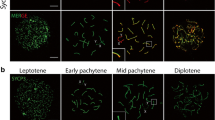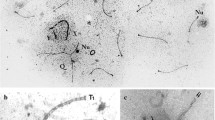Abstract
Pairing of pachytene chromosomes was studied in oocytes and spermatocytes of mice heterozygous for the male-sterile Is(7;1)40H insertion using light and electron microscopy for synaptonemal complex analysis in surface-spread, silver-stained preparations. The data comprised four males and four female embryos. The insertion/deletion configurations appeared as either two bivalents or one quadrivalent in both sexes, but the proportion of bivalents was higher in oocytes. Some insertion and deletion bivalents showed synaptic adjustment. The insertion/deletion configurations were associated with, or adjacent to, the XY bivalent in the majority of spermatocytes. End-to-end association of different bivalents was more frequent in oocytes than in spermatocytes. It is suggested that physiological differences between male and female gametocytes may lead to the difference in their reproductive potential.
Similar content being viewed by others
References
Beechey CV, Kirk M, Searle AG (1980) A reciprocal translocation induced in an oocyte and affecting fertility in male mice. Cytogenet Cell Genet 27:129–146
Boer P de, Branje HEB (1979) Association of the extra chromosome of tertiary trisomic male mice with the sex chromosomes during first meiotic prophase, and its significance for impairment of spermatogenesis. Chromosoma 73:369–379
Boer P de, Searle AG (1980) Workshop on chromosomal aspects of male sterility in mammals: summary and synthesis. J Reprod Fertil 60:257–265
Dresser ME, Moses MJ (1980) Synaptonemal complex karyotyping in spermatocytes of the Chinese hamster (Cricetulus griseus). IV. Light and electron microscopy of synapsis and nucleolar development by silver staining. Chromosoma 76:1–22
Epstein CJ (1969) Mammalian oocytes: X chromosome activity. Science 163:1078–1079
Forejt J (1982) X-Y involvement in male sterility caused by autosome translocations — a hypothesis. In: Crosignani PG, Rubin BL, Fraccaro M (eds) Genetic control of gamete production and function. Academic Press, London, pp 135–151
Forejt J, Gregorová S (1977) Meiotic studies of translocations causing male sterility in the mouse. I. Autosomal reciprocal translocations. Cytogenet Cell Genet 19:159–179
Forejt J, Gregorová S, Goetz P (1981) XY pair associates with the synaptonemal complex of autosomal male-sterile translocations in pachytene spermatocytes of the mouse. Chromosoma 82:41–53
Howell WM, Black DA (1980) Controlled silver staining of nucleolus organizer regions with a protective colloidal developer: a 1-step method. Experientia 36:1014–1015
Johannisson R, Gropp A, Winking H, Coerdt W, Rehder H, Schwinger E (1983) Down's syndrome in the male. Reproductive pathology and meiotic studies. Hum Genet 63:132–138
Lyon MF, Meredith R (1966) Autosomal translocations causing male sterility and viable aneuploidy in the mouse. Cytogenetics 5:335–354
Mittwoch U, Mahadevaiah S, Olive MS (1981) Retardation of ovarian growth in male-sterile mice carrying an autosomal translocation. J Med Genet 18:414–417
Moses MJ, Poorman PA (1981) Synaptonemal complex analysis of mouse chromosomal rearrangements. II. Synaptic adjustment in a tandem duplication. Chromosoma 81:519–535
Moses MJ, Poorman PA (in press) Synapsis, synaptic adjustment and DNA synthesis in mouse oocytes. In: Gropp A, Wolf U (eds) Chromosomes today 8
Moses MJ, Poorman PA, Roderick TH, Davisson MT (1982) Synaptonemal complex analysis of mouse chromosomal rearrangements. IV. Synapsis and synaptic adjustment in two paracentric inversions. Chromosoma 84:457–474
Rooij DG de (1980) Spermatogenesis in mice heterozygous for a male-sterile translocation. Cytogenet Cell Genet 27:210–211
Searle AG (1981) Chromosomal variants. In: Green MC (ed) Genetic variants and strains of the laboratory mouse. Gustav Fischer, Stuttgart, pp 324–357
Searle AG (1982) The genetics of sterility in the mouse. In: Crosignani PG, Rubin BL, Fraccaro M (eds) Genetic control of gamete production and function. Academic Press, London, pp 93–114
Searle AG, Beechey CV (1981) Map of reciprocal translocations and insertions. In: Green MC (ed) Genetic variants and strains of the laboratory mouse. G Fischer, Stuttgart, pp 360–365
Searle AG, Beechey CV, Evans EP (1978) Meiotic effects in chromosomally derived male sterility of mice. Ann Biol Anim Biochem Biophys 18:391–398
Searle AG, Beechey CV, de Boer P, de Rooij DG, Evans EP, Kirk M (1983) A male-sterile insertion in the mouse. Cytogenet Cell Genet 36:617–626
Speed RM (1982) Meiosis in the foetal mouse ovary. I. An analysis at the light microscope level using surface-spreading. Chromosoma 85:427–437
Sung WK, Jagiello G (1982) A technique for light and electron microscopy of the synaptonemal complex of the mouse oocyte. Can J Genet Cytol 24:675–680
Author information
Authors and Affiliations
Additional information
The authors warmly dedicate this paper to the Founder and Senior Editor of Chromosoma, Professor Hans Bauer, on the occasion of his 80th birthday.
Rights and permissions
About this article
Cite this article
Mahadevaiah, S., Mittwoch, U. & Moses, M.J. Pachytene chromosomes in male and female mice heterozygous for the Is(7;1)40H insertion. Chromosoma 90, 163–169 (1984). https://doi.org/10.1007/BF00292392
Received:
Revised:
Issue Date:
DOI: https://doi.org/10.1007/BF00292392




